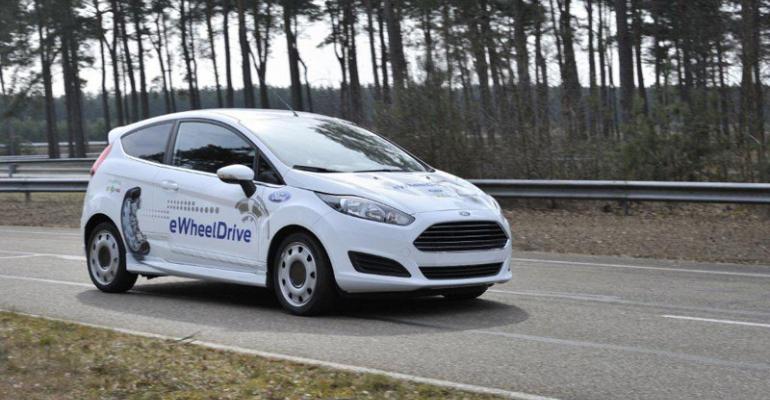Ford and Schaeffler are inching closer to having a production-ready version of the supplier’s eWheelDrive technology, which propels a vehicle via an electric motor in each of the rear wheels.
Raphael Fischer, director-wheel hub drives product group, Schaeffler eMobility Systems division, says the technology that has been in development the past six years could go into production as early as 2018.
“We have a target for 2018 because you can’t spend time in advanced development all the time; you just want to reach a target,” he tells WardsAuto. “The project from the beginning was to find a new way to open new horizons of mobility.”
Because the motors, braking and cooling systems are housed in the wheels, eWheelDrive technology frees up space in the vehicle where a traditional drivetrain normally would be.
The technology could lead to the development of a 4-person car that occupies only the space of a 2-person model, making the vehicle more agile and able to move sideways to park.
Fischer says a vehicle powered by eWheelDrive would be an ideal fit in an emerging market such as China, where “they don’t have enough space in the cities to use common vehicles, so they are looking for new opportunities.”
Although there are more limited opportunities in developed regions such as the U.S. and Europe, Fisher says, eWheelDrive technology could prove beneficial in commercial vehicles or urban car-sharing programs.
An eWheelDrive vehicle entering production likely would not be very fast or have extended range. Fisher envisions a microcar powered by a battery producing about 62 lb.-ft. (84 Nm) of torque via the wheels with a top speed of 81 mph (130 km/h) and a range of 93 miles (150 km).
While Schaeffler has headed up the project since the beginning, Ford stepped in about two years ago and has financed further development of the technology.
“Ford is more than just a customer; they are developer partners in this project,” Fischer says. “We’ve learned a lot from each other in this context.”
With Ford’s backing, the technology, installed in a Fiesta B-car, recently underwent cold-weather testing in Sweden and chassis modifications. An early prototype eWheelDrive vehicle is undergoing further testing in the auto maker’s hometown of Dearborn, MI, with the goal of producing two more drivable vehicles by 2015.
Fischer says the biggest obstacle to perfecting the technology is creating a dedicated platform, which can costs millions to develop and produce.
With Ford’s help, Fisher hopes Schaeffler can get there, but he says until a platform is developed and vehicles can be produced in quantity, a production eWheelDrive car would be cost-prohibitive.
“It’s difficult to get a low price if you don’t have economies of scale,” he says. “It’s a challenge for anybody that wants to bring drive systems like that to market.”





